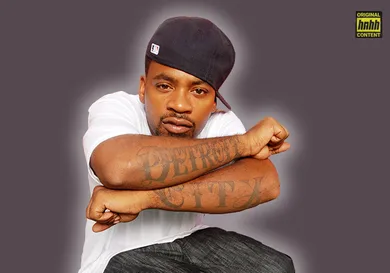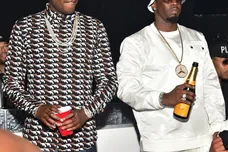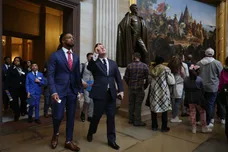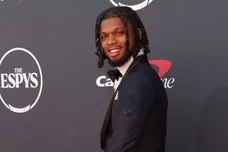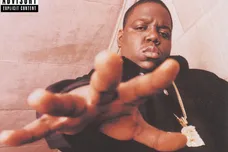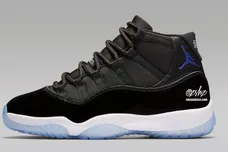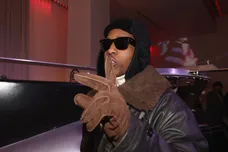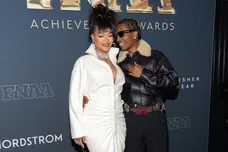While every genre of music has its fair share of one-hit wonders, no other art form has the ability to hoist someone up on the culture’s collective shoulders before unceremoniously dropping them back to earth quite like hip-hop. Whether through a hit album or a sudden run of momentum that makes people think that maybe, just maybe, they could be witnessing the rise of a new force in hip-hop in real-time, there are certain artists who capture the spirit of the times and can do no wrong in the eyes of the consumer base.
Once positioned as a mainstay who had all of the tools, talent, and charisma to etch his name in the history books, Obie Trice's early successes as one of the leading lights of Shady Records have since given way to a prolonged and agonizing period defined by both independence and a gradual slide towards obscurity.
Meaning that now, his name is more commonly seen in the news cycle due to some infraction in his personal life rather than anticipation over a new project from the 44-year-old MC.
Presently held in a Michigan County Jail on a $10,000 bond after it was alleged that he’d made threatening calls to his ex-girlfriend, the rapper’s journey from the toast of the game back to a resilient stalwart of the underground is one of many stories of this ilk which leave fans wondering where and why it all derailed.
And for Obie, there isn’t a singular cause for his fading fortunes, but a whole host of adverse circumstances and seemingly inconsequential decisions which would have a massive impact on his ability to retain his place in the pack. Like the vast majority of MCs, Obie’s hip-hop career arose from humble beginnings and by way of a DIY approach.
"I had put out some independent music a long time ago, some vinyl records. 'Mr. Trice,' 'Dope, Job, Homeless,' 'Gimmie My DAT Back,' 'Well Known Asshole,'" he reflected during a 2020 interview with HNHH. "All these songs I put out back then kinda gave me a push in Detroit. I was known here in the city. During that time, Marshall was getting on with his career. He got a whiff of me and he got it popping from there."
Obie Trice and Eminem, 2002 - Jim Smeal/Ron Galella Collection/Getty Images
A familiar face at the sort of inner-city hip-hop hotspots that would be recreated in 8 Mile, Obie’s initial encounters with Em were so impromptu that at the time, it didn’t register as anything seismic. However, with the benefit of hindsight, Obie recognized the positive effect that fostering a relationship with Shady had on his life.
"It was a hot summer day and Eminem had just dropped The Marshall Mathers LP and I shot out there from the hood, jumped in the Regal, shot up there to the studio and spit for him from the passenger side of his car and gave him a CD and he was like, 'Aight, I’ll holla,'" he recalled to Baller Status back in the day.
"I really didn’t think nothing of it. At that time in my life, my whole thought process was all fu**ed up. I ain’t really seen the future with what I was going through. It wasn’t like, ‘Oh my God I just met Eminem.’ I really didn’t see the vision that I could be saved or found like that until I got the phone call that they were ready for me. He changed my life around. He definitely changed my change in my pocket."
After signing to Shady in 2002, Em took it upon himself to preface Obie’s arrival in the mainstream as best as he could by providing opportunities for him to spit on high-profile projects. After the “Obie Trice” skit on D12’s Devil’s Night, Obie’s “Real Name No Gimmicks” tagline from his breakout single “Rap Name” would be inserted into the opening salvo of the global smash hit and The Eminem Show lead single “Without Me.” Paired with stellar contributions to the label’s famed DJ Green Lantern-aided Invasion tape, his hyper-descriptive verse on “Drips” and a chance to rhyme alongside Em and DMX on “Go To Sleep” from The Cradle To The Grave OST, Obie had built up plenty of steam long before it was time to unveil his debut solo album, Cheers, in September of 2003.
Recorded and released within a chaotic timespan for the Shady camp, Obie has said that the end product contains the ambiance of that tumultuous period within every bar and beat. "When I was making that record, we still was doing shows and getting into situations where shit could have got real bad out there. Getting in fights, traveling everywhere. Getting into situations with different individuals in the industry. There was a lot going on when I was making Cheers."
Led by iconic tracks such as “Got Some Teeth” “We All Die One Day” and “Lady”, the record catapulted Obie to number five on the Billboard charts and would eventually be certified as gold by the RIAA. With that, Obie was living the lavish lifestyle of an Interscope-backed artist.
Although there would be three years in between the records, Obie was initially undaunted by the prospect of following Cheers, an album which he now routinely describes as "my classic." "Nah, man, that don’t put no pressure on me," he said in October of 2003. "I’m gonna do my own thing. Obie Trice is his own individual. I can only do what I can do – that’s bring good music. And hopefully it’ll take off from there."
Armed with a distinctive flow and propensity for wordplay that made for enthralling listening at every turn, it was clear that Obie had big plans. And unlike many others, he didn’t intend to play second fiddle and has since claimed that he “bodied” Eminem every time they converged on a track together. But as life and label drama intervened in his creative process, Obie would soon learn that things weren’t as simple as he’d envisioned back when he was basking in the glow of Cheers’ success.
Alongside getting shot in his native Detroit– and gaining a bullet in his forehead which is lodged there to this day, an interview with Global Grind saw him discuss issues that hampered the creative process of his eventual sophomore album, Second Rounds On Me.
"I’ve been through a lot. A lot has been going on with me prior to the Shady thing. Even before Second Rounds On Me came out, a lot of things were going on. Sometimes things get to be overwhelming… Three months after [Obie got shot], Proof was killed. Just a lot of things, man."
Released in August of 2006, Second Rounds On Me is a record in which he hoped to escape his mentor’s looming shadow.
"That was a record that I really kind of did myself and brought it to Eminem’s attention because I didn’t believe that he should be working on my album, D12’s album, 50 Cent and he’s an artist as well," he informed DJ Vlad. "I just wanted to give him a break, but he kinda had to be involved in every project at the time."
Where his debut album had shifted over 200,000 copies in its first week, his second record sold only 74,000 and while this was by no means a flop, it did seem to suggest that his star power had dwindled to a certain degree. While it could be argued that three years was too big of a hiatus, what undoubtedly didn’t help matters is that along the way, he had gained the ire of one of music’s most powerful and resolutely headstrong figures in Jimmy Iovine.
"I missed the Big Boy show (Power 106 Los Angeles)," he said of where the issues with his label boss stemmed from. "The Interscope reps picked me up from the airport that night. I think it was a Thursday, I had to be on the show early Friday… and they took me out. These guys took me out. This is my first time in Cali, I’m from the hood… I’m on the radio. So, they took me out. We didn’t get in until 4:30, 5 in the morning and they wanted me up in about an hour and a half. I was outta there. Jimmy Iovine was like, ‘You can’t be missing the Big Boy show, you just can’t miss those things.’ Why would your people put me in that situation?. I wanted to put my records out quicker than they were released… but you know, they want Em to be involved all the time. [Interscope] wouldn’t open the budget."
Scott Gries/Getty Images
Here, we can pinpoint where the seeds of Obie’s eventual departure from the majors were sown. While having Shady’s backing is one thing, you’ll never have the full promotional might of a record company conglomerate if you find yourself on the CEO’s mental scrapheap. As a consequence, no album you release on their imprint could ever reach its full potential.
Two years on from the release of Second Rounds On Me, Obie would announce that he’d departed from Shady and Interscope. Rather than harboring any ill will towards Em, he conceded that much of the reason for having to leave fell on him. "I didn’t seize the moment when I should’ve," he informed HipHopDx, "so I had to move on and that’s just how things go, it’s a business first and that’s just how it was."
Left feeling stunted by Iovine’s distaste for him, Obie later suggested that for all his ties to Eminem were integral in providing him with access to a global platform in the first place, his label boss’ spats with the likes of The Source and BET did limit the avenues that his music could appear in as well as who he could collaborate with.
"Back then, when Em didn’t move, we did suffer some consequences from that," he mused. "When I asked for a beat from Pharrell from the N*E*R*D, in order for him to give me a beat, Eminem had to get on one of his songs and one of his beats as well. It was like a 'We give you this and then you can get this.'"
Over the years, Obie has been willing to engage in self-reflection. He has suggested that he, to a certain degree, was in the right place at the wrong time in order to become a flagship artist of Interscope. More specifically, he believed that the unique aura and crossover appeal of labelmate and occasional collaborator 50 Cent had the unintended effect of placing a ceiling on what Shady’s other protege could accomplish.
"50 really did it to me men!" he lamented to Hot 97 in 2015. "If there was no 50 Cent, my shit would have been outta here. All that momentum he had, like 'Wanksta'...when he came out. You know, it was like, 'we fuck with Obie, but man! This guy right here is like Tupac. He was shot 9 times? Oh shit!' So, I'm like damn! I'm talking to my brother was my manager at the time I was like 'damn, we got to get shot out here.'"
Although he was in the throes of label drama, it didn’t hamper Obie’s creativity, and his eventual third album, Bottom’s Up, was originally slated to come out on Shady. In a testament to the fact that their bond could endure any business-oriented strife, Shady made an appearance on the track “Richard” alongside retaining a production credit with “Going No Where.” The first record on his own label Black Market Entertainment, its 2012 release would mark his last appearance on the charts at number 130.
A far cry from the heady heights of his early career, Obie has remained at this plateau ever since, and due to the long lead times between projects, the momentum of days gone by has proven impossible to regain.
Dropped in 2015, The Hangover arrived three years after it was initially teased with the lure of production from Warren G. By the time it came out, any contributions from the g-funk icon were missing in action. To date, his last project came in the form of 2019’s The Fifth and while it was well-received by fans and featured a collaboration with Xzibit on “Space,” it never made any notable splash akin to what he’d commanded, even on Bottom’s Up.
Later that same year, Obie would demonstrate his undying loyalty to Eminem when he interjected himself into his feud with Nick Cannon.
Across "Spanky Hayes" 1 & 2, Obie demonstrated that his acidic pen and tendency to fuse comical rhymes with an air of menace was certainly still intact. In doing so, he reinforced the fact that even if the world’s attention skewed elsewhere, Obie Trice, real name, no gimmicks, has never once let up even when some of those who owned well-worn copies of Cheers had, perhaps, stopped checking for him.
